The (not so-new) latest New Leonardo Discovery
On 29 September it was widely reported that researchers at the Louvre now believe that a drawing at the Musée Condé in Chantilly – the so-called “Joconde nue” – to be Leonardo’s lost preparatory nude study for the Mona Lisa.
The claimed discovery seemed bold and unleashed global coverage – see, for example, the BBC’s ‘Mona Lisa nude sketch’ found in France, National Geographic’s ‘Nude Mona Lisa’ Sketch May Have Been da Vinci’s, and Fortune’s ‘Historians Think They’ve Found a Nude Drawing of Mona Lisa’
In reality, this latest New Leonardo Discovery is a warm-up of an old, on-the-record, attribution. In 1988 Jacques Franck, the art historian/painter trained in Old Master techniques (and a current restoration adviser to the Louvre), had closely examined the Joconde nue in the Château of Chantilly along with Amélie Lefébure, former Head curator of the Musée Condé, and Dominique Le Marois, a restorer in the French museums. At that date the drawing had long been considered the work of an anonymous Leonardo imitator and contemporary but on close visual examination Franck concluded that it was mostly executed by Leonardo and he advised the then director of the Chantilly Estate, Prof. Germain Bazin, accordingly. His (written) ascription was accepted by leading Leonardo specialists, including Profs. Bazin and René Huyghe.
Above, Fig. 1: Here attributed to Leonardo da Vinci, Joconde nue, c. 1500-1506 ?, black chalk on brown prepared paper, 72 x 54 cm. Chantilly, Musée Condé, Inv. 32 (27).
Above, Fig. 2: a detail of Joconde nue (as published showing prick marks when the design was transferred for use on panel.)
Because the Joconde nue had been heavily retouched over the centuries and rendered barely legible in many sections, some thought it necessary that it be subjected to a wide range of forensic tests. This was rejected by Prof. Bazin for fear that, should the work be widely accepted as a true Leonardo, it would then undergo a drastic and likely harmful cleaning. Although forensic investigations have improved significantly in the last thirty years, that risk remains. On his personal recollections of the sheet and in the light of the restorer M. Le Marois’s alarming and still extant 1988 condition report, Franck now fears that an essentially technical underpinning of the Leonardo ascription will prompt further and more invasive technical interventions. He tells AWUK:
“The Joconde nue’s authentication by scientific means will be quite a challenge to the Louvre’s laboratory. For sure they will be able to check the paper and date it correctly, yet the materials in themselves cannot establish that the drawing is the work of Leonardo himself as opposed to that of a close disciple. The composition has been considerably harmed by apocryphal retouchings and the pricking for transfer onto a panel to get an oil painting out of it [See Fig. 2 above and Fig. 5 below]. Further, at a later date, possibly in the 19th century, some thick aqueous paint was applied to the background in order to conceal various alterations (stains, rings, etc.). As a result, many of the forms are hardly legible in terms of Leonardo’s artistic standards.
“The brutal interference of the alterations with the impalpable modelling on which Leonardo’s overall drawing is based has grossly denatured it. When I realized this, I intended to clean the work ‘virtually’ by reconstructing the drawn composition as closely as possible to what it had once been. The task would have been huge but this reaffirmation of my conclusions on the drawing’s status provides a compelling and urgent occasion for that task to be undertaken soon. The growing conceit of restorers that they can recover original states that have been largely subsumed within alien and deleterious additions has repeatedly been shown to be foolhardy with Leonardo.”
As in 1988, the authenticity of the Chantilly cartoon should stand or fall today on the strength of its aesthetic force and originality, which is to say: as seen by eye and not on the basis of some technical analysis of the drawing’s component material innards. Nearly three decades ago Jacques Franck felt that he had seen enough with his trained draughtsman’s eye to make a firm ascription to Leonardo (as was reported in letters to the then director) and today he recalls that:
“Besides the characteristics of Leonardo’s late style visible in so many chalk drawings (either red or black), kept notably in the Queen’s collections at Windsor, what struck me at once was the hands. Their execution reminded me of the underdrawing of the Mona Lisa’s own hands in the Louvre picture as revealed in infrared light [See Figs. 3, 4, 6, 7 and 8]. Although such forensics weren’t as developed in 1988 as they are now, at the time the extant infrared images of the Mona Lisa [see Fig. 7 for a more recent image] were defined well enough to help my eye notice that extraordinary resemblance between the painted and drawn hands at first glance. Leonardo had clearly used a very fine brush to trace the contours of the fingers in the cartoon and the painting, hence the thin outlines to be seen in the fingers in both. This similarity isn’t mere chance, it simply means that the hands and, of course the rest of the cartoon is indeed a Leonardo work. Also, the Joconde nue’s forefinger was obviously longer at the outset [Figs. 7 and 8] but Leonardo changed his mind and reduced its length afterwards using wash, exactly as it is in the Louvre picture now. A crucial pentimento probably meaning that the Chantilly cartoon preceded the painted version of the famous portrait.”
Above, Fig. 3: (left) Leonardo da Vinci, Studies of hands, c. 1480-81, silver-point on pink prepared paper, Windsor Castle, Royal Library, n° 12616; (right) a section of Leonardo da Vinci, the Adoration of the Magi, 1480-81, oil on wood panel, 246 x 243 cm. Florence, Uffizi Gallery, Inv. 1890 : n° 1594.
Above, Fig. 4: (left) a detail of the hands of Joconde nue, at Fig. 1; (right) Leonardo da Vinci, Studies of a woman’s hands, c. 1478 (?), silver-point, heightened with white on pink prepared paper, 21. 5 x 15 cm. Windsor Castle, Royal Library, n° 12558.
Above, Fig. 5: (left) Joconde nue; (right) After Leonardo da Vinci, Joconde nue as Primavera, 16th century (?), 89 x 65 cm. Switzerland, private collection (formerly Mackenzie collection).
Above, Fig. 6: a detail of Joconde nue showing prick marks used for transferring the design, and, the artist’s revision and shortening of the index finger.
Above, Fig. 7: (top) the revised right hand of Joconde nue and (bottom), by way of comparison, a circa 2004 Louvre infra-red image (all rights reserved) of the right hand of the Mona Lisa.
Above, Fig. 8: showing (top) the revised right hand of Joconde nue with the first state of the forefinger indicated in red and the revised state indicated in yellow – graphic by Gareth Hawker; (centre) the right hand of Joconde nue and, by way of comparison, (bottom) the right hand of the Mona Lisa as seen in the Louvre infra-red image at Fig. 7.
Michael Daley, 3 October 2017


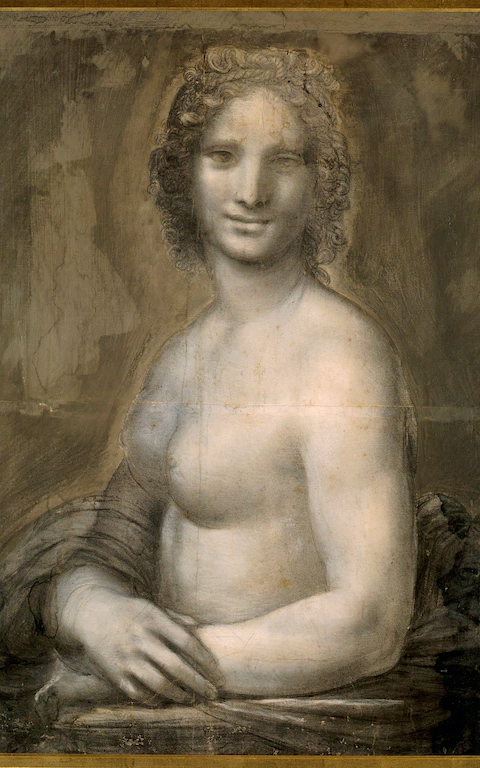
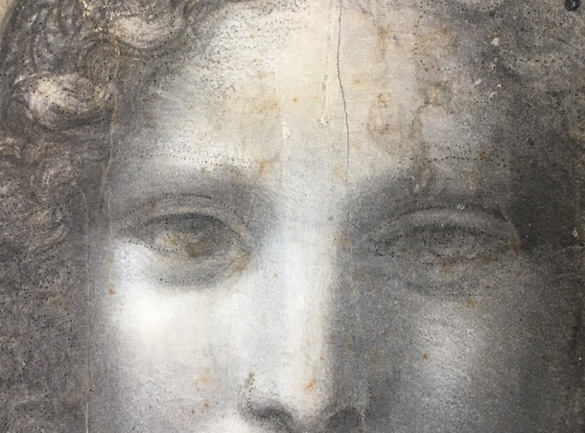

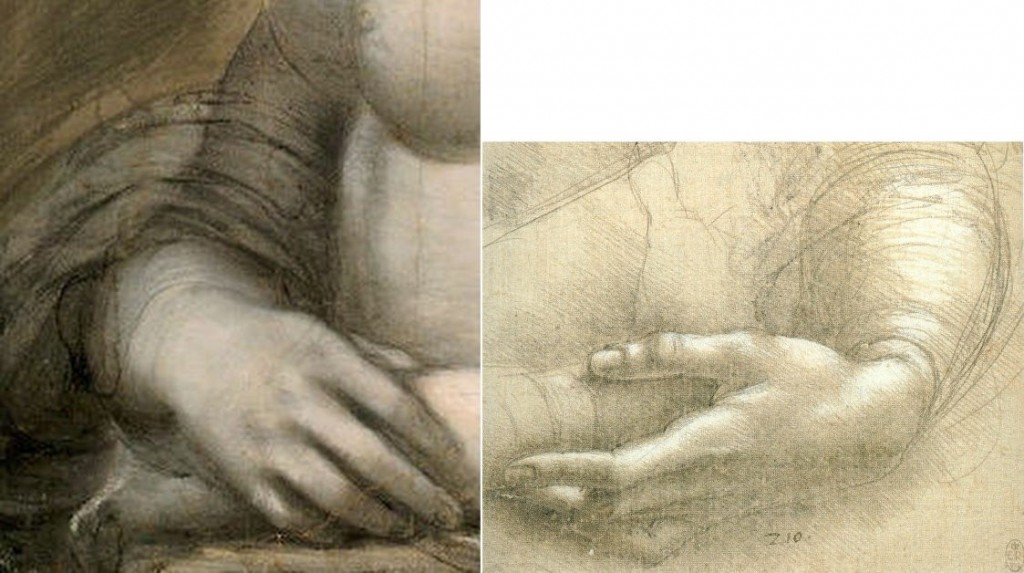
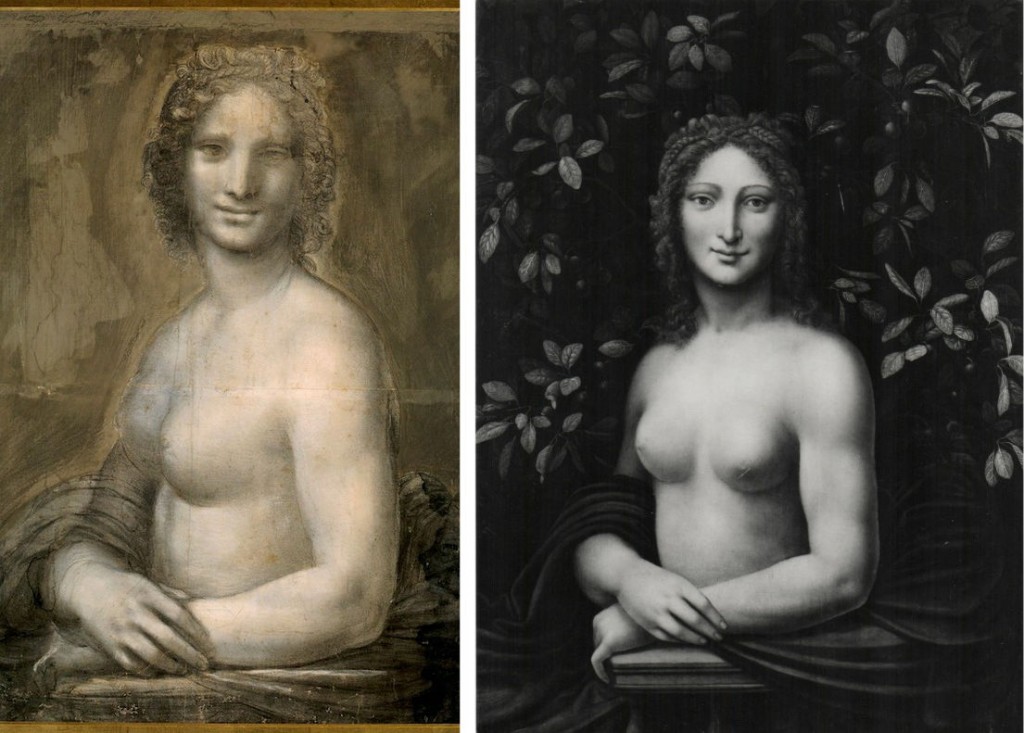


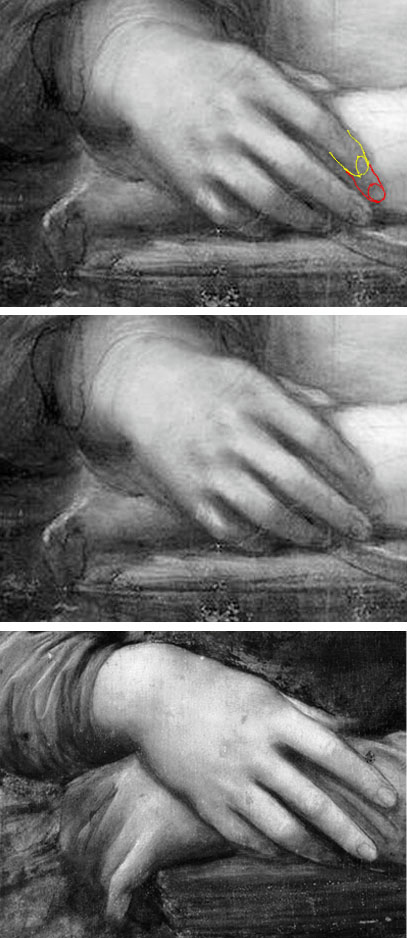
Leave a Reply